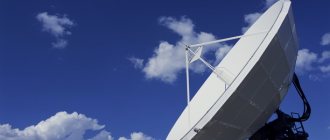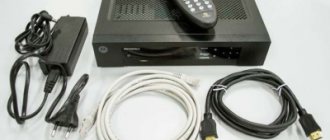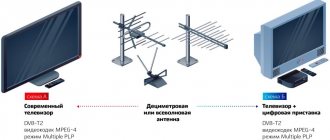Dates for the transition to DTV in the capital and Moscow region in 2019
The transition from analogue to digital broadcasting in Russia is carried out in stages. In Moscow and the Moscow region, the shutdown will begin on April 15, 2021 and will affect exclusively users of terrestrial television broadcasting, of which there are only 1% in the region. The remaining households are connected to cable television or use satellite or Internet television. In this regard, preparations are made in advance for receiving a digital signal.
How to connect to digital yourself?
To make the switch to digital yourself, you first need to make sure that the signal coverage area allows you to configure your TV to receive over-the-air channels, since this is not always the case. For this:
- They go to the website of the Russian Television and Radio Broadcasting Network (RTRS), find an interactive map, enter the address in the search bar, and put a tick in the “Frequency zones” item.
- They find the icon of the television tower closest to the house, click on it, thus getting the coverage area of this tower and the type of broadcast packets.
In Moscow, digital broadcasting is transmitted by the Ostankino TV tower, covering 100% of the capital's area.
If you have the necessary equipment and configure the TV correctly, Muscovites have the opportunity to connect and watch 20 channels for free.
Next, using the instructions for the TV or the “Search for information about TV” service located on the RTRS website, find out whether the TV supports the DVB-T2 standard. To do this, enter the brand and model of the device in the appropriate fields.
A TV that supports the DVB-T2 format is configured using the remote control. No additional equipment required. To connect to a TV that does not have a built-in DVB-T2 tuner, you need a set-top box that supports the corresponding format.
What is the difference between DVB-C and DVB-T and DVB-S
DVB-C:
- Broadcast cable as a broadcast form.
- The compression used is MPEG-2 or MPEG-4.
- 16 QAM or 256 QAM data modulation.
- RS encoder as FEC.
- The circuit contains an alternating module.
- Subscribers receive a signal from the provider, a cable is used.
- The DVB-C format uses frequencies from 55.25 to 403.25 MHz.
DVB-T:
- Terrestrial short form of broadcasting.
- The modulation scheme is OFDM coded.
- The content is transmitted uncompressed in MPEG.
- QPSK, 16 QAM, 64 QAM – data modulation schemes.
- An external RS (204,188) encoder is used, as well as an internal convolutional one.
- The interleaver is suitable for both internal and external.
- Frequency VHF and UHF channels with 6 MHz, 7 MHz, 8 MHz (bandwidth).
DVB-S:
- Broadcasting via satellite.
- MPEG-2 compression is used.
- C-band and Ku-band frequencies can be used.
- FEC methods - DBS receiver error correction.
- Transmission occurs via LHCP and RHCP.
- The DVB-S standard requires an antenna that is smaller in size.
What equipment do you need to purchase?
Digital television works on the same principle as analogue television - the signal distributed by the broadcaster through terrestrial repeaters is distributed throughout the area and received by antennas. The digital signal operates in the UHF range; suitable equipment is required to receive and decipher the signal.
To receive a digital signal, you will need a TV with a built-in receiver that supports T2 and a screen resolution of more than 720 pixels to watch TV shows in HD quality.
TVs released before 2012 do not have a built-in tuner, so it must be purchased separately.
The device is presented in the form of a digital set-top box connected to a TV and in the form of a board designed to be soldered into the device. The device converts the binary signal into a familiar form and displays it on the screen.
An antenna is also required that is capable of receiving and transmitting via cable a signal received from the emission of decimeter waves.
Antennas are divided into several types:
- Collective. Provides TV signals to all residents of an apartment building. The power does not differ from the external one.
- Outdoor. Suitable for country houses and cottages. Installed on roofs or walls. Depending on the model and the presence of an amplifier, they are capable of picking up a signal at a distance of 10-50 km from the repeater, ensuring high signal quality, including in difficult terrain.
- Room. The range is 3-10 km, installed in areas of reliable reception in direct visibility from the television tower, in the absence of interference along the way.
Of the variety of types of antennas, the best ones are Polish antennas , which do their job well in conditions of uneven terrain and obstacles in the way in the form of forests. Or delta type devices operating in the HF and VHF bands, capable of receiving and deciphering even a weak signal.
The antenna is positioned towards the transmitter and is securely fixed.
The easiest way to provide television broadcasting in digital format will be for cable television subscribers, since this process is organized by the company providing this service. All you need is a TV with a built-in receiver or purchased separately.
In what case is a set-top box and antenna not needed?
Before connecting to digital broadcasting, check what type of signal is currently being received. To do this, turn on the central channels:
- NTV;
- REN-TV;
- TNT;
- STS;
- "RUSSIA 1";
- TVC and others.
The letter “A” next to the channel logo indicates that analogue broadcasting is carried out and certain actions will be required to switch to digital.
The absence of a letter means the following:
- terrestrial television has already switched to digital broadcasting;
- according to the agreement between the Moscow city authorities and cable television operators, analogue cable broadcasting will not be switched off;
- The user initially broadcasts digitally (Internet TV or satellite TV).
In the second case, to switch to digital you will not need to purchase a receiver and antenna.
What to do if your TV does not support digital format
Digital TV is broadcast via the DVB-T2 channel. Only modern TVs can decode this standard. To find out whether your TV supports this channel, carefully study the technical specifications of the device.
If the TV does not support DVB-T2, then there are several ways out of this situation:
- purchasing a new TV;
- purchase and installation of a digital receiver.
Of course, the second option is the priority. The cost of the tuner will directly depend on the functionality. For example, on the modern market there is a wide range of set-top boxes with the ability to record content on flash media.
Instructions for setting up your TV to watch over-the-air channels
To set up a TV with a built-in receiver, you will need to do the following:
- Disconnect the TV from the power supply.
- Connect the cable from the antenna to the antenna connector on the TV.
- Turn on the TV by connecting it to the power supply.
- Go to the settings menu, activate the TV tuner.
- Follow the steps to automatically search for TV programs specified in the operating instructions. The channel search is carried out manually by entering the channel number and its frequency.
For devices that do not support the DVB-T2 format, you must purchase special additional equipment - a digital set-top box called a receiver.
One set-top box is designed to connect to one TV, so users who have several TVs purchase a set-top box for each of them.
The digital set-top box is connected to the TV and configured:
- Disconnect the TV from the power supply.
- Insert the antenna cable into the antenna connector on the set-top box. Audio and video cables are connected to the corresponding connectors on the set-top box and on the TV, marked in different colors for convenience.
- Turn on the TV by connecting it to the mains.
- Go to the receiver menu, select the required signal source: AV, SCART, HDMI and others.
- Perform an automatic search for TV programs as indicated in the operating instructions.
The set-top box can be connected via several ports:
- The best option is if the TV has an HDMI connector, which allows you to transmit a larger amount of information in improved quality and is designed specifically for multimedia.
- The second option is AV ports, made in the form of bells of different colors: red;
- white;
- yellow.
The manual method of searching for channels is more effective and allows you to set up a high-quality image, which is not possible to set up in automatic mode.
The channel frequency for manual tuning can be found on the website rtrs.rf.
Do not forget that the quality of broadcasting is affected by:
- magnetic storms;
- change of time of day;
- air temperature and humidity, etc.
Prospects for the dvb c standard
The main condition for the ability to use DVB-C is the presence of the right provider in the house, which will provide cable TV and Internet services, as well as the cable itself. This format provides the user with high quality image and sound. It is not afraid of interference and is more stable than analog. In addition, the standard remains in demand for other reasons. Unlike the satellite option, the signal is transmitted via cable. The user will be free from noise, crackling and the “snow” effect. It is worth adding that programs and films can be watched in HD and SD format.
Connecting to this standard is also not a problem. If the building has cable TV, then you can start using it without leaving your apartment. Many users watch television not only on TV, but also on PC. To do this, a tuner and a card are required to gain access. Most adherents of this standard note that the channels function perfectly and without interruptions.
Available free channels
Depending on the location of the user, broadcasting is possible from two broadcasters at once. The permissible distance is at least 10-15 kilometers. At a greater distance, you will have to change the antenna to a more powerful one .
Each of the broadcasters transmits 10 channels available for free use:
- RTRS - TVC, channel 11, NTV, Russia K, Russia 1, Match!, Carousel, channel 5, Public Television of Russia, Russia 24;
- RTRS-2 - Ren-TV, STS, MIR, SPAS, Domashny, Zvezda, Friday, TNT, Muz-TV, TV3.
The repeaters operate independently of each other; in order to watch all 20 channels of both packages, it is necessary to receive the signal from RTRS-1 and RTRS-2 simultaneously.
The first multiplex broadcasts channels around the clock, with a single TV program. The list of TV channels is supplemented by 3 radio channels broadcasting around the clock.
The second multiplex appeared later, its coverage area was smaller.
Currently, test broadcasting of 3 multiplexes is underway from the Ostankino Tower at a frequency of 578 MHz, distributed within a radius of 100 km from the source and available to residents of Moscow and the region. The list of channels for it has not yet been approved; it is only known that it consists of 40 channels.
Last changes
26.06.2020
The consideration of court case No. A63-7770/2020 dated 06/08/2020 in the first instance has been completed. Organization as a defendant, the amount of claims is RUB 1,155,210,066.
08.06.2020
New court case No. A63-7770/2020 dated 06/08/2020 as a defendant, the amount of claims is RUB 1,155,210,066.
27.05.2020
New enforcement proceedings No. 34096/20/26014-IP dated May 27, 2020, amount of claims: RUB 286,619.
- Review of paid iptv providers using ott technology
06.04.2020
New government procurement as a customer, contract No. 1386819875326070225, counterparty: Astra LLC
25.12.2019
New enforcement proceedings No. 70791/19/26014-IP dated December 25, 2019, amount of claims: RUB 213,405.
10.12.2019
Enforcement proceedings No. 38342/19/26014-IP dated July 30, 2019 have been completed
19.11.2019
New government procurement as a customer, contract No. 9702296603260702259, counterparty: Ecoyug LLC
29.10.2019
New government procurement as a customer, contract No. 2813334079326070225, counterparty: Ecoyug LLC











